Business Environment Analysis and Research Methods
VerifiedAdded on 2021/02/21
|19
|5361
|39
AI Summary
This assignment provides a comprehensive review of literature related to business environment, including concepts, models, strategies, and systems. It covers various aspects such as business ethics, social responsibility, and sustainable development. The provided references include papers from reputable sources like Routledge, Palgrave Macmillan, and Oxford University Press, among others. These papers cover topics like value mapping for sustainability, user interface design, and the impact of business environment on output and productivity in Africa. Additionally, there are patents related to controlling use of a business environment on mobile devices. The assignment is suitable for students and researchers looking for best practices and case studies in business environments.
Contribute Materials
Your contribution can guide someone’s learning journey. Share your
documents today.
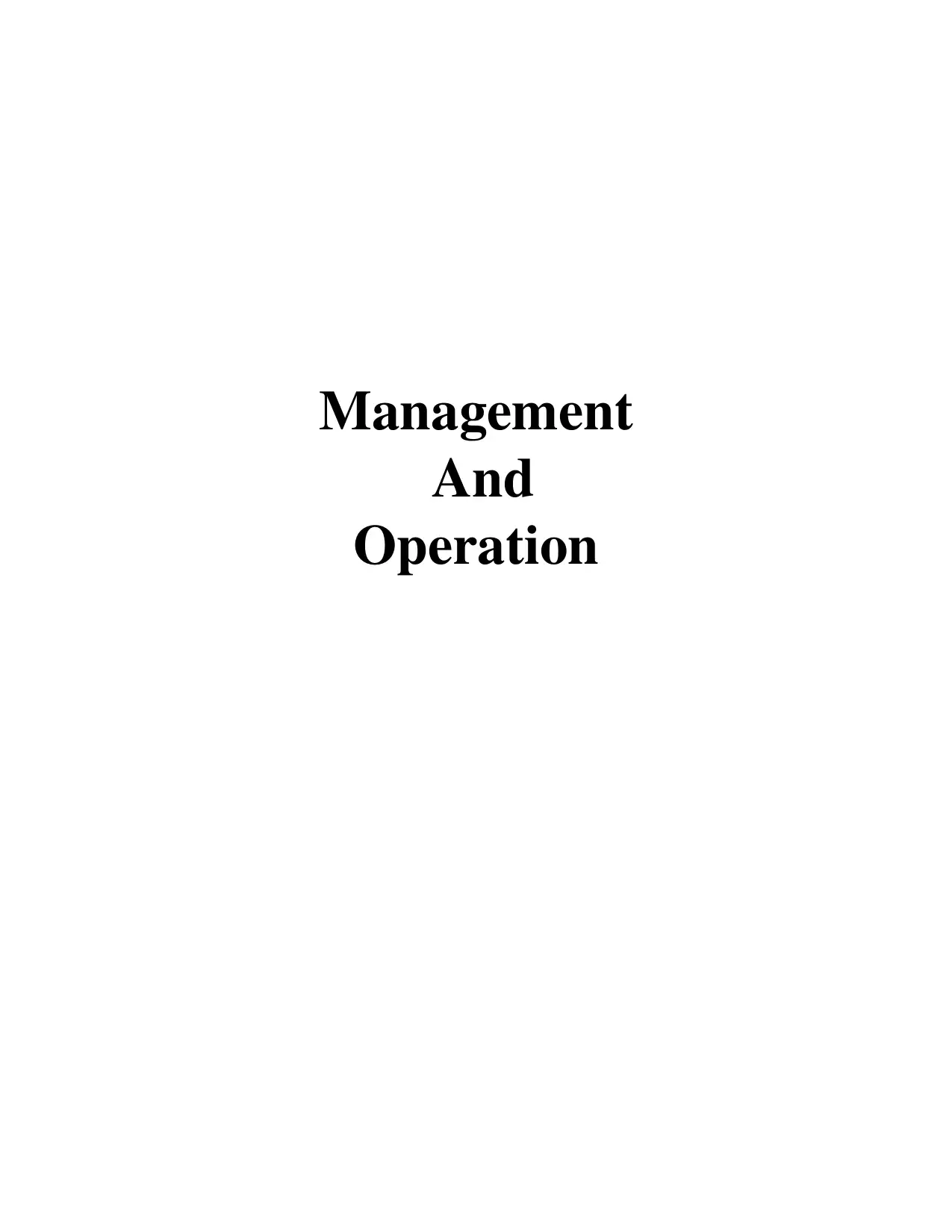
Management
And
Operation
And
Operation
Secure Best Marks with AI Grader
Need help grading? Try our AI Grader for instant feedback on your assignments.
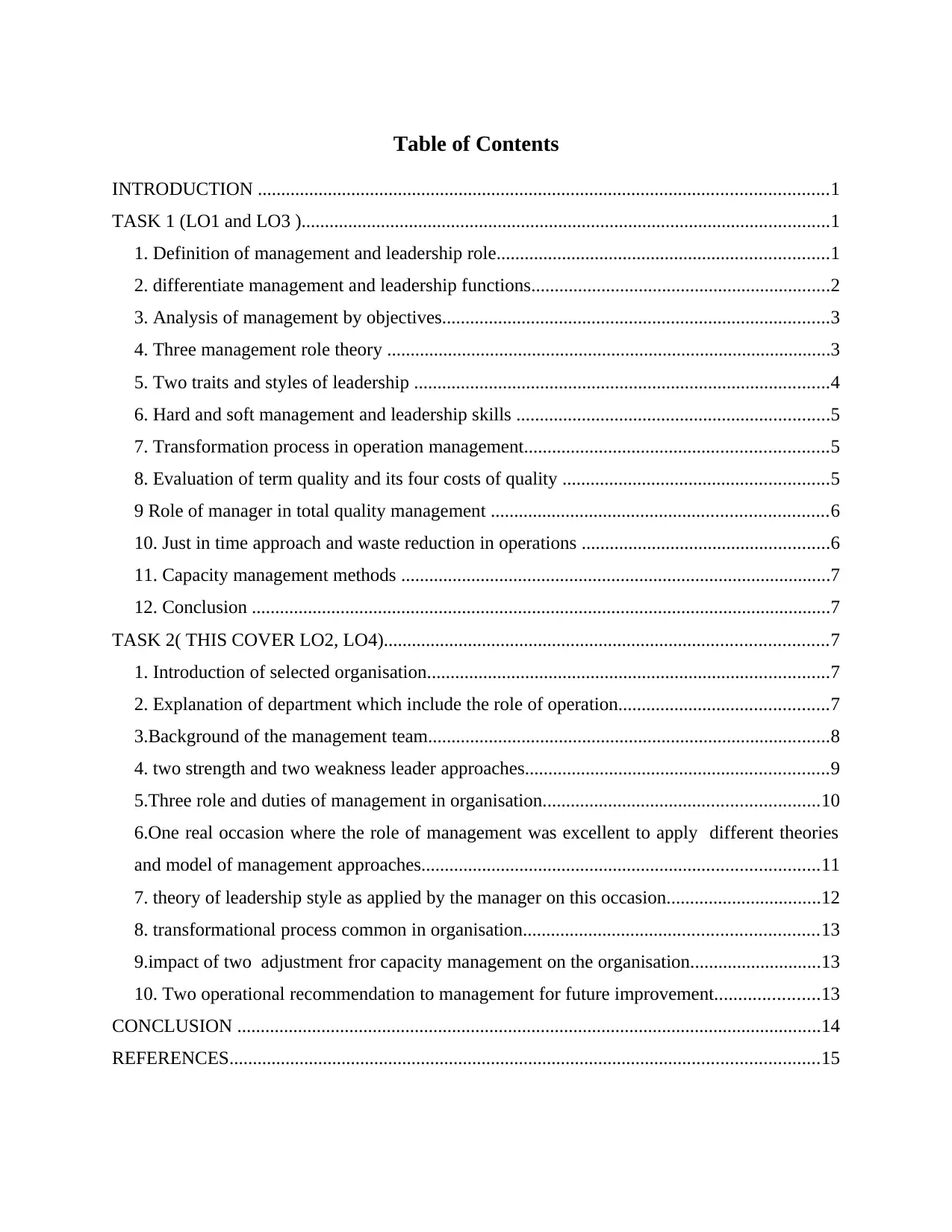
Table of Contents
INTRODUCTION ..........................................................................................................................1
TASK 1 (LO1 and LO3 ).................................................................................................................1
1. Definition of management and leadership role.......................................................................1
2. differentiate management and leadership functions................................................................2
3. Analysis of management by objectives...................................................................................3
4. Three management role theory ...............................................................................................3
5. Two traits and styles of leadership .........................................................................................4
6. Hard and soft management and leadership skills ...................................................................5
7. Transformation process in operation management.................................................................5
8. Evaluation of term quality and its four costs of quality .........................................................5
9 Role of manager in total quality management ........................................................................6
10. Just in time approach and waste reduction in operations .....................................................6
11. Capacity management methods ............................................................................................7
12. Conclusion ............................................................................................................................7
TASK 2( THIS COVER LO2, LO4)...............................................................................................7
1. Introduction of selected organisation......................................................................................7
2. Explanation of department which include the role of operation.............................................7
3.Background of the management team......................................................................................8
4. two strength and two weakness leader approaches.................................................................9
5.Three role and duties of management in organisation...........................................................10
6.One real occasion where the role of management was excellent to apply different theories
and model of management approaches.....................................................................................11
7. theory of leadership style as applied by the manager on this occasion.................................12
8. transformational process common in organisation...............................................................13
9.impact of two adjustment fror capacity management on the organisation............................13
10. Two operational recommendation to management for future improvement......................13
CONCLUSION .............................................................................................................................14
REFERENCES..............................................................................................................................15
INTRODUCTION ..........................................................................................................................1
TASK 1 (LO1 and LO3 ).................................................................................................................1
1. Definition of management and leadership role.......................................................................1
2. differentiate management and leadership functions................................................................2
3. Analysis of management by objectives...................................................................................3
4. Three management role theory ...............................................................................................3
5. Two traits and styles of leadership .........................................................................................4
6. Hard and soft management and leadership skills ...................................................................5
7. Transformation process in operation management.................................................................5
8. Evaluation of term quality and its four costs of quality .........................................................5
9 Role of manager in total quality management ........................................................................6
10. Just in time approach and waste reduction in operations .....................................................6
11. Capacity management methods ............................................................................................7
12. Conclusion ............................................................................................................................7
TASK 2( THIS COVER LO2, LO4)...............................................................................................7
1. Introduction of selected organisation......................................................................................7
2. Explanation of department which include the role of operation.............................................7
3.Background of the management team......................................................................................8
4. two strength and two weakness leader approaches.................................................................9
5.Three role and duties of management in organisation...........................................................10
6.One real occasion where the role of management was excellent to apply different theories
and model of management approaches.....................................................................................11
7. theory of leadership style as applied by the manager on this occasion.................................12
8. transformational process common in organisation...............................................................13
9.impact of two adjustment fror capacity management on the organisation............................13
10. Two operational recommendation to management for future improvement......................13
CONCLUSION .............................................................................................................................14
REFERENCES..............................................................................................................................15

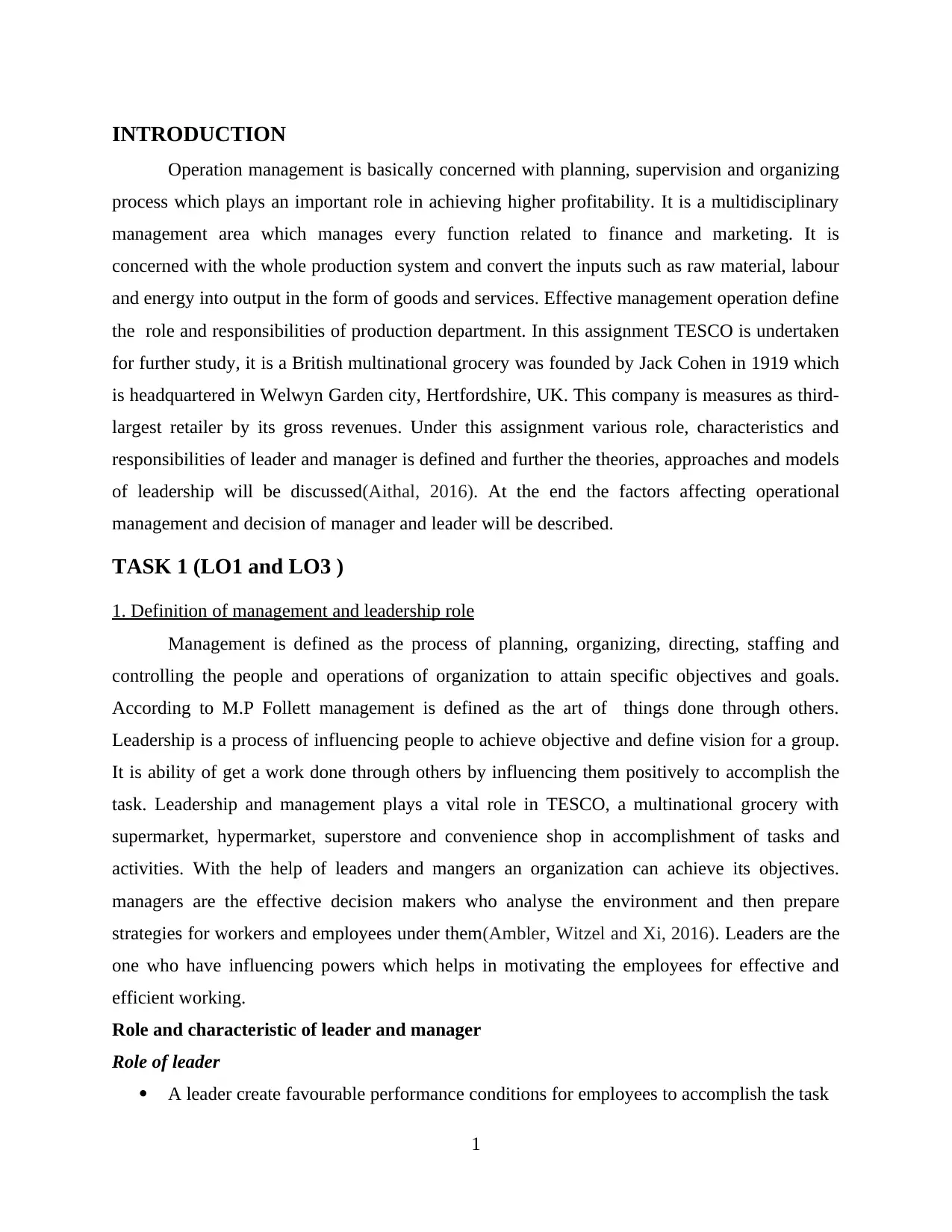
INTRODUCTION
Operation management is basically concerned with planning, supervision and organizing
process which plays an important role in achieving higher profitability. It is a multidisciplinary
management area which manages every function related to finance and marketing. It is
concerned with the whole production system and convert the inputs such as raw material, labour
and energy into output in the form of goods and services. Effective management operation define
the role and responsibilities of production department. In this assignment TESCO is undertaken
for further study, it is a British multinational grocery was founded by Jack Cohen in 1919 which
is headquartered in Welwyn Garden city, Hertfordshire, UK. This company is measures as third-
largest retailer by its gross revenues. Under this assignment various role, characteristics and
responsibilities of leader and manager is defined and further the theories, approaches and models
of leadership will be discussed(Aithal, 2016). At the end the factors affecting operational
management and decision of manager and leader will be described.
TASK 1 (LO1 and LO3 )
1. Definition of management and leadership role
Management is defined as the process of planning, organizing, directing, staffing and
controlling the people and operations of organization to attain specific objectives and goals.
According to M.P Follett management is defined as the art of things done through others.
Leadership is a process of influencing people to achieve objective and define vision for a group.
It is ability of get a work done through others by influencing them positively to accomplish the
task. Leadership and management plays a vital role in TESCO, a multinational grocery with
supermarket, hypermarket, superstore and convenience shop in accomplishment of tasks and
activities. With the help of leaders and mangers an organization can achieve its objectives.
managers are the effective decision makers who analyse the environment and then prepare
strategies for workers and employees under them(Ambler, Witzel and Xi, 2016). Leaders are the
one who have influencing powers which helps in motivating the employees for effective and
efficient working.
Role and characteristic of leader and manager
Role of leader
A leader create favourable performance conditions for employees to accomplish the task
1
Operation management is basically concerned with planning, supervision and organizing
process which plays an important role in achieving higher profitability. It is a multidisciplinary
management area which manages every function related to finance and marketing. It is
concerned with the whole production system and convert the inputs such as raw material, labour
and energy into output in the form of goods and services. Effective management operation define
the role and responsibilities of production department. In this assignment TESCO is undertaken
for further study, it is a British multinational grocery was founded by Jack Cohen in 1919 which
is headquartered in Welwyn Garden city, Hertfordshire, UK. This company is measures as third-
largest retailer by its gross revenues. Under this assignment various role, characteristics and
responsibilities of leader and manager is defined and further the theories, approaches and models
of leadership will be discussed(Aithal, 2016). At the end the factors affecting operational
management and decision of manager and leader will be described.
TASK 1 (LO1 and LO3 )
1. Definition of management and leadership role
Management is defined as the process of planning, organizing, directing, staffing and
controlling the people and operations of organization to attain specific objectives and goals.
According to M.P Follett management is defined as the art of things done through others.
Leadership is a process of influencing people to achieve objective and define vision for a group.
It is ability of get a work done through others by influencing them positively to accomplish the
task. Leadership and management plays a vital role in TESCO, a multinational grocery with
supermarket, hypermarket, superstore and convenience shop in accomplishment of tasks and
activities. With the help of leaders and mangers an organization can achieve its objectives.
managers are the effective decision makers who analyse the environment and then prepare
strategies for workers and employees under them(Ambler, Witzel and Xi, 2016). Leaders are the
one who have influencing powers which helps in motivating the employees for effective and
efficient working.
Role and characteristic of leader and manager
Role of leader
A leader create favourable performance conditions for employees to accomplish the task
1
Secure Best Marks with AI Grader
Need help grading? Try our AI Grader for instant feedback on your assignments.
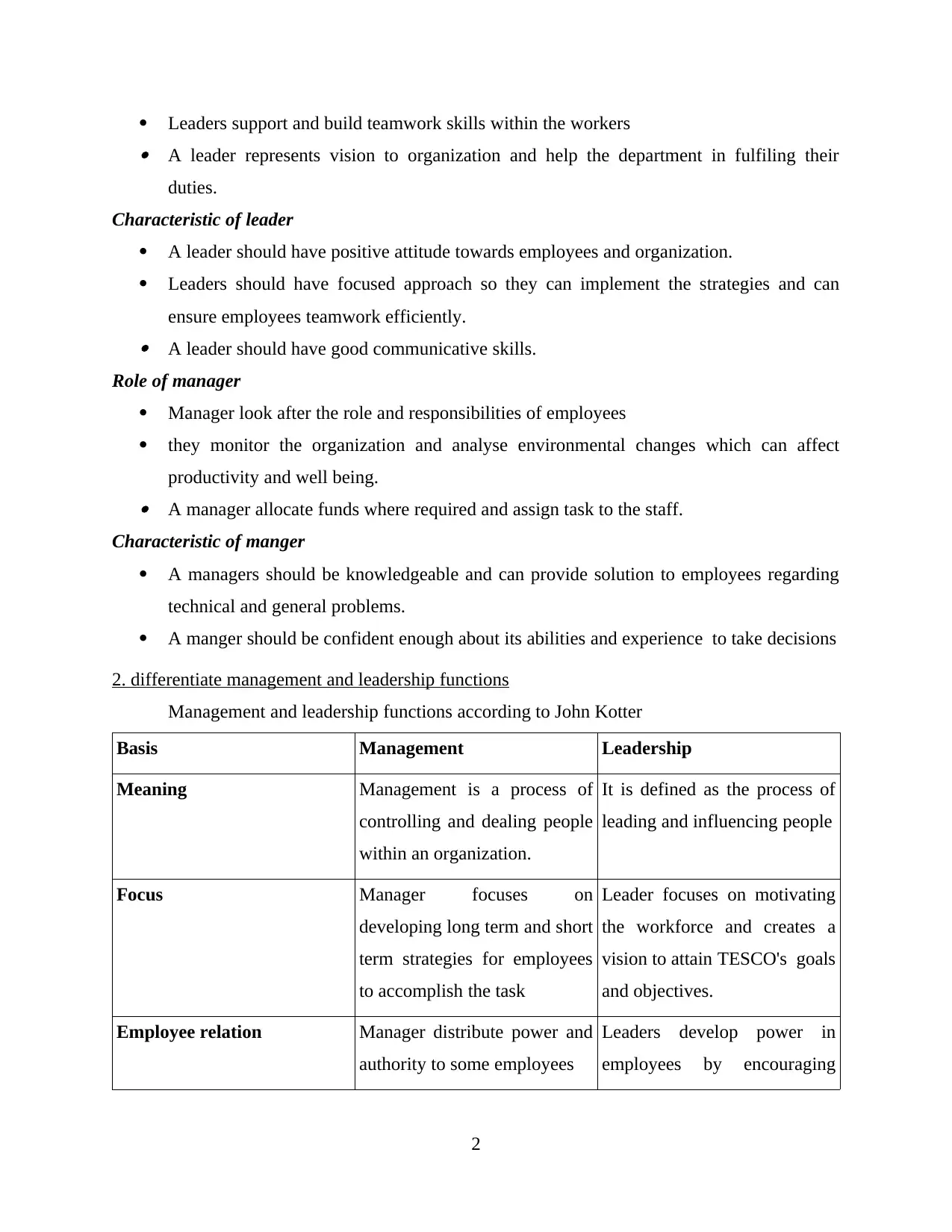
Leaders support and build teamwork skills within the workers A leader represents vision to organization and help the department in fulfiling their
duties.
Characteristic of leader
A leader should have positive attitude towards employees and organization.
Leaders should have focused approach so they can implement the strategies and can
ensure employees teamwork efficiently. A leader should have good communicative skills.
Role of manager
Manager look after the role and responsibilities of employees
they monitor the organization and analyse environmental changes which can affect
productivity and well being. A manager allocate funds where required and assign task to the staff.
Characteristic of manger
A managers should be knowledgeable and can provide solution to employees regarding
technical and general problems.
A manger should be confident enough about its abilities and experience to take decisions
2. differentiate management and leadership functions
Management and leadership functions according to John Kotter
Basis Management Leadership
Meaning Management is a process of
controlling and dealing people
within an organization.
It is defined as the process of
leading and influencing people
Focus Manager focuses on
developing long term and short
term strategies for employees
to accomplish the task
Leader focuses on motivating
the workforce and creates a
vision to attain TESCO's goals
and objectives.
Employee relation Manager distribute power and
authority to some employees
Leaders develop power in
employees by encouraging
2
duties.
Characteristic of leader
A leader should have positive attitude towards employees and organization.
Leaders should have focused approach so they can implement the strategies and can
ensure employees teamwork efficiently. A leader should have good communicative skills.
Role of manager
Manager look after the role and responsibilities of employees
they monitor the organization and analyse environmental changes which can affect
productivity and well being. A manager allocate funds where required and assign task to the staff.
Characteristic of manger
A managers should be knowledgeable and can provide solution to employees regarding
technical and general problems.
A manger should be confident enough about its abilities and experience to take decisions
2. differentiate management and leadership functions
Management and leadership functions according to John Kotter
Basis Management Leadership
Meaning Management is a process of
controlling and dealing people
within an organization.
It is defined as the process of
leading and influencing people
Focus Manager focuses on
developing long term and short
term strategies for employees
to accomplish the task
Leader focuses on motivating
the workforce and creates a
vision to attain TESCO's goals
and objectives.
Employee relation Manager distribute power and
authority to some employees
Leaders develop power in
employees by encouraging
2
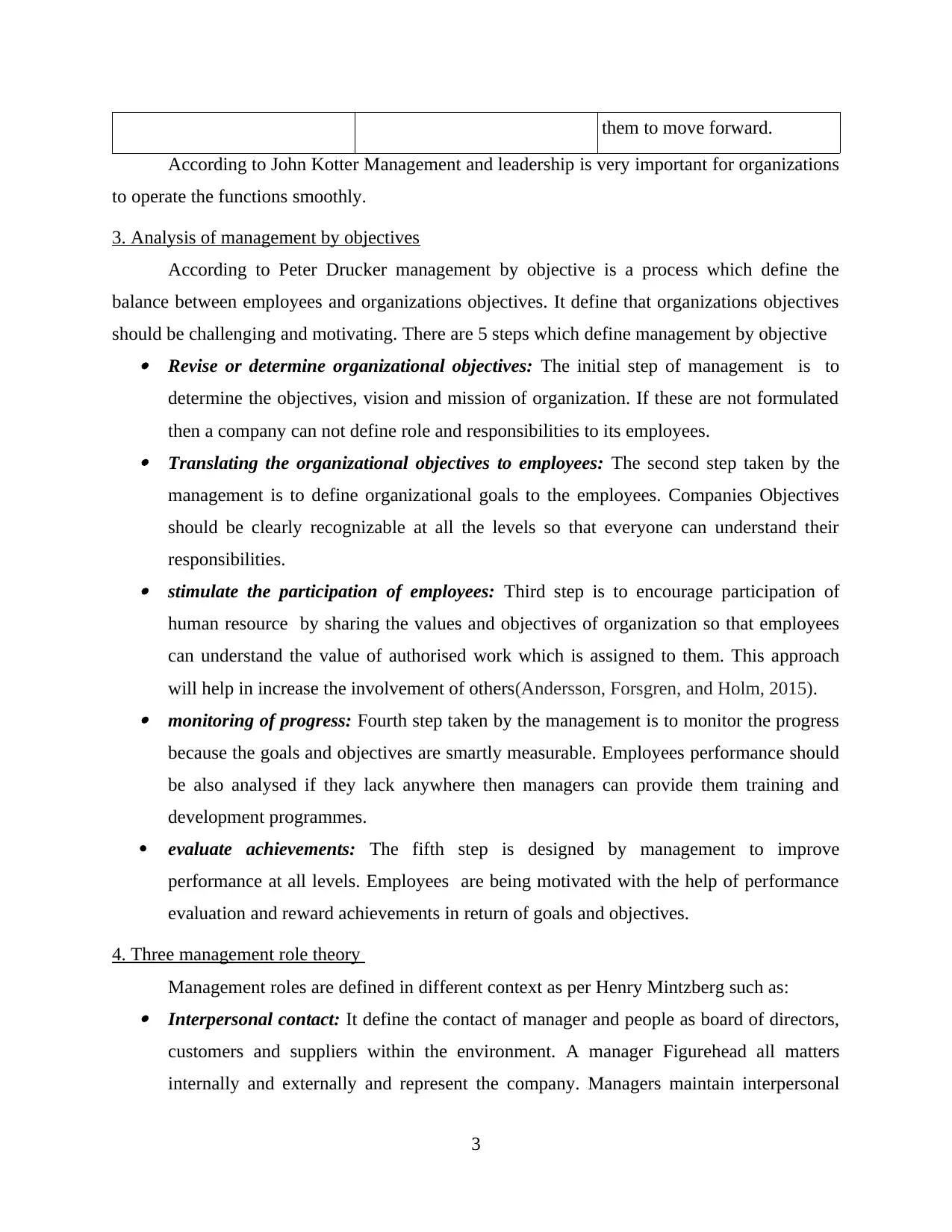
them to move forward.
According to John Kotter Management and leadership is very important for organizations
to operate the functions smoothly.
3. Analysis of management by objectives
According to Peter Drucker management by objective is a process which define the
balance between employees and organizations objectives. It define that organizations objectives
should be challenging and motivating. There are 5 steps which define management by objective Revise or determine organizational objectives: The initial step of management is to
determine the objectives, vision and mission of organization. If these are not formulated
then a company can not define role and responsibilities to its employees. Translating the organizational objectives to employees: The second step taken by the
management is to define organizational goals to the employees. Companies Objectives
should be clearly recognizable at all the levels so that everyone can understand their
responsibilities. stimulate the participation of employees: Third step is to encourage participation of
human resource by sharing the values and objectives of organization so that employees
can understand the value of authorised work which is assigned to them. This approach
will help in increase the involvement of others(Andersson, Forsgren, and Holm, 2015). monitoring of progress: Fourth step taken by the management is to monitor the progress
because the goals and objectives are smartly measurable. Employees performance should
be also analysed if they lack anywhere then managers can provide them training and
development programmes.
evaluate achievements: The fifth step is designed by management to improve
performance at all levels. Employees are being motivated with the help of performance
evaluation and reward achievements in return of goals and objectives.
4. Three management role theory
Management roles are defined in different context as per Henry Mintzberg such as: Interpersonal contact: It define the contact of manager and people as board of directors,
customers and suppliers within the environment. A manager Figurehead all matters
internally and externally and represent the company. Managers maintain interpersonal
3
According to John Kotter Management and leadership is very important for organizations
to operate the functions smoothly.
3. Analysis of management by objectives
According to Peter Drucker management by objective is a process which define the
balance between employees and organizations objectives. It define that organizations objectives
should be challenging and motivating. There are 5 steps which define management by objective Revise or determine organizational objectives: The initial step of management is to
determine the objectives, vision and mission of organization. If these are not formulated
then a company can not define role and responsibilities to its employees. Translating the organizational objectives to employees: The second step taken by the
management is to define organizational goals to the employees. Companies Objectives
should be clearly recognizable at all the levels so that everyone can understand their
responsibilities. stimulate the participation of employees: Third step is to encourage participation of
human resource by sharing the values and objectives of organization so that employees
can understand the value of authorised work which is assigned to them. This approach
will help in increase the involvement of others(Andersson, Forsgren, and Holm, 2015). monitoring of progress: Fourth step taken by the management is to monitor the progress
because the goals and objectives are smartly measurable. Employees performance should
be also analysed if they lack anywhere then managers can provide them training and
development programmes.
evaluate achievements: The fifth step is designed by management to improve
performance at all levels. Employees are being motivated with the help of performance
evaluation and reward achievements in return of goals and objectives.
4. Three management role theory
Management roles are defined in different context as per Henry Mintzberg such as: Interpersonal contact: It define the contact of manager and people as board of directors,
customers and suppliers within the environment. A manager Figurehead all matters
internally and externally and represent the company. Managers maintain interpersonal
3
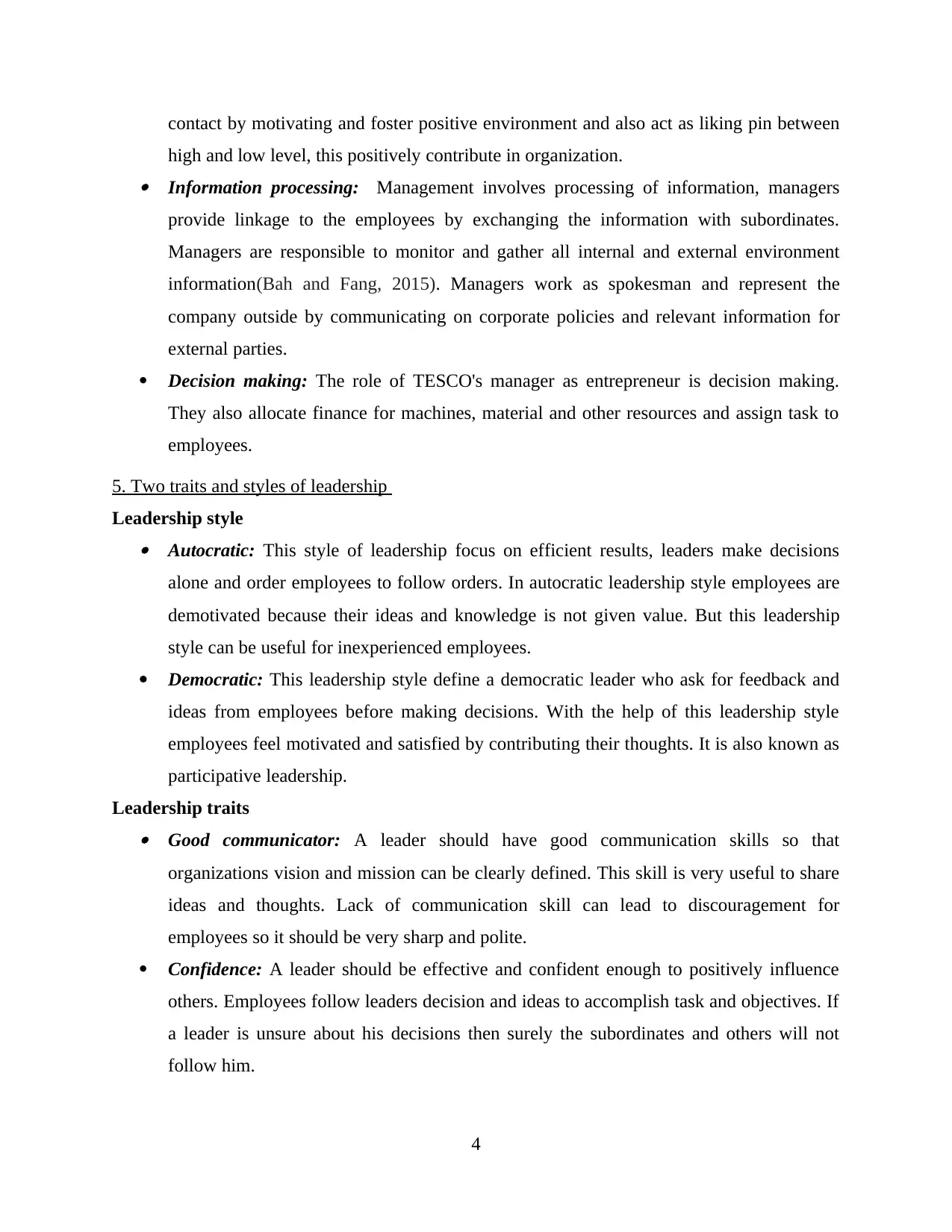
contact by motivating and foster positive environment and also act as liking pin between
high and low level, this positively contribute in organization. Information processing: Management involves processing of information, managers
provide linkage to the employees by exchanging the information with subordinates.
Managers are responsible to monitor and gather all internal and external environment
information(Bah and Fang, 2015). Managers work as spokesman and represent the
company outside by communicating on corporate policies and relevant information for
external parties.
Decision making: The role of TESCO's manager as entrepreneur is decision making.
They also allocate finance for machines, material and other resources and assign task to
employees.
5. Two traits and styles of leadership
Leadership style Autocratic: This style of leadership focus on efficient results, leaders make decisions
alone and order employees to follow orders. In autocratic leadership style employees are
demotivated because their ideas and knowledge is not given value. But this leadership
style can be useful for inexperienced employees.
Democratic: This leadership style define a democratic leader who ask for feedback and
ideas from employees before making decisions. With the help of this leadership style
employees feel motivated and satisfied by contributing their thoughts. It is also known as
participative leadership.
Leadership traits Good communicator: A leader should have good communication skills so that
organizations vision and mission can be clearly defined. This skill is very useful to share
ideas and thoughts. Lack of communication skill can lead to discouragement for
employees so it should be very sharp and polite.
Confidence: A leader should be effective and confident enough to positively influence
others. Employees follow leaders decision and ideas to accomplish task and objectives. If
a leader is unsure about his decisions then surely the subordinates and others will not
follow him.
4
high and low level, this positively contribute in organization. Information processing: Management involves processing of information, managers
provide linkage to the employees by exchanging the information with subordinates.
Managers are responsible to monitor and gather all internal and external environment
information(Bah and Fang, 2015). Managers work as spokesman and represent the
company outside by communicating on corporate policies and relevant information for
external parties.
Decision making: The role of TESCO's manager as entrepreneur is decision making.
They also allocate finance for machines, material and other resources and assign task to
employees.
5. Two traits and styles of leadership
Leadership style Autocratic: This style of leadership focus on efficient results, leaders make decisions
alone and order employees to follow orders. In autocratic leadership style employees are
demotivated because their ideas and knowledge is not given value. But this leadership
style can be useful for inexperienced employees.
Democratic: This leadership style define a democratic leader who ask for feedback and
ideas from employees before making decisions. With the help of this leadership style
employees feel motivated and satisfied by contributing their thoughts. It is also known as
participative leadership.
Leadership traits Good communicator: A leader should have good communication skills so that
organizations vision and mission can be clearly defined. This skill is very useful to share
ideas and thoughts. Lack of communication skill can lead to discouragement for
employees so it should be very sharp and polite.
Confidence: A leader should be effective and confident enough to positively influence
others. Employees follow leaders decision and ideas to accomplish task and objectives. If
a leader is unsure about his decisions then surely the subordinates and others will not
follow him.
4
Paraphrase This Document
Need a fresh take? Get an instant paraphrase of this document with our AI Paraphraser
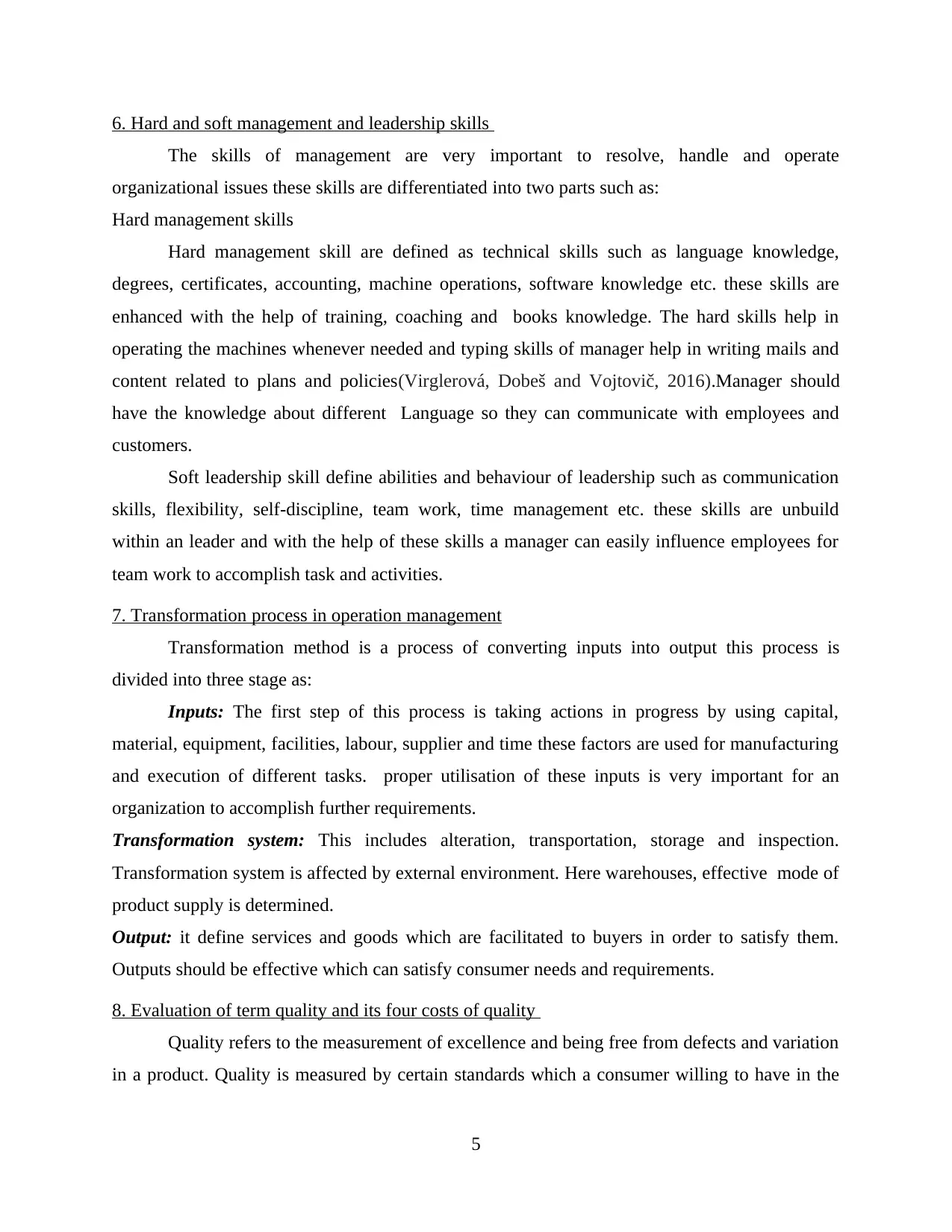
6. Hard and soft management and leadership skills
The skills of management are very important to resolve, handle and operate
organizational issues these skills are differentiated into two parts such as:
Hard management skills
Hard management skill are defined as technical skills such as language knowledge,
degrees, certificates, accounting, machine operations, software knowledge etc. these skills are
enhanced with the help of training, coaching and books knowledge. The hard skills help in
operating the machines whenever needed and typing skills of manager help in writing mails and
content related to plans and policies(Virglerová, Dobeš and Vojtovič, 2016).Manager should
have the knowledge about different Language so they can communicate with employees and
customers.
Soft leadership skill define abilities and behaviour of leadership such as communication
skills, flexibility, self-discipline, team work, time management etc. these skills are unbuild
within an leader and with the help of these skills a manager can easily influence employees for
team work to accomplish task and activities.
7. Transformation process in operation management
Transformation method is a process of converting inputs into output this process is
divided into three stage as:
Inputs: The first step of this process is taking actions in progress by using capital,
material, equipment, facilities, labour, supplier and time these factors are used for manufacturing
and execution of different tasks. proper utilisation of these inputs is very important for an
organization to accomplish further requirements.
Transformation system: This includes alteration, transportation, storage and inspection.
Transformation system is affected by external environment. Here warehouses, effective mode of
product supply is determined.
Output: it define services and goods which are facilitated to buyers in order to satisfy them.
Outputs should be effective which can satisfy consumer needs and requirements.
8. Evaluation of term quality and its four costs of quality
Quality refers to the measurement of excellence and being free from defects and variation
in a product. Quality is measured by certain standards which a consumer willing to have in the
5
The skills of management are very important to resolve, handle and operate
organizational issues these skills are differentiated into two parts such as:
Hard management skills
Hard management skill are defined as technical skills such as language knowledge,
degrees, certificates, accounting, machine operations, software knowledge etc. these skills are
enhanced with the help of training, coaching and books knowledge. The hard skills help in
operating the machines whenever needed and typing skills of manager help in writing mails and
content related to plans and policies(Virglerová, Dobeš and Vojtovič, 2016).Manager should
have the knowledge about different Language so they can communicate with employees and
customers.
Soft leadership skill define abilities and behaviour of leadership such as communication
skills, flexibility, self-discipline, team work, time management etc. these skills are unbuild
within an leader and with the help of these skills a manager can easily influence employees for
team work to accomplish task and activities.
7. Transformation process in operation management
Transformation method is a process of converting inputs into output this process is
divided into three stage as:
Inputs: The first step of this process is taking actions in progress by using capital,
material, equipment, facilities, labour, supplier and time these factors are used for manufacturing
and execution of different tasks. proper utilisation of these inputs is very important for an
organization to accomplish further requirements.
Transformation system: This includes alteration, transportation, storage and inspection.
Transformation system is affected by external environment. Here warehouses, effective mode of
product supply is determined.
Output: it define services and goods which are facilitated to buyers in order to satisfy them.
Outputs should be effective which can satisfy consumer needs and requirements.
8. Evaluation of term quality and its four costs of quality
Quality refers to the measurement of excellence and being free from defects and variation
in a product. Quality is measured by certain standards which a consumer willing to have in the
5
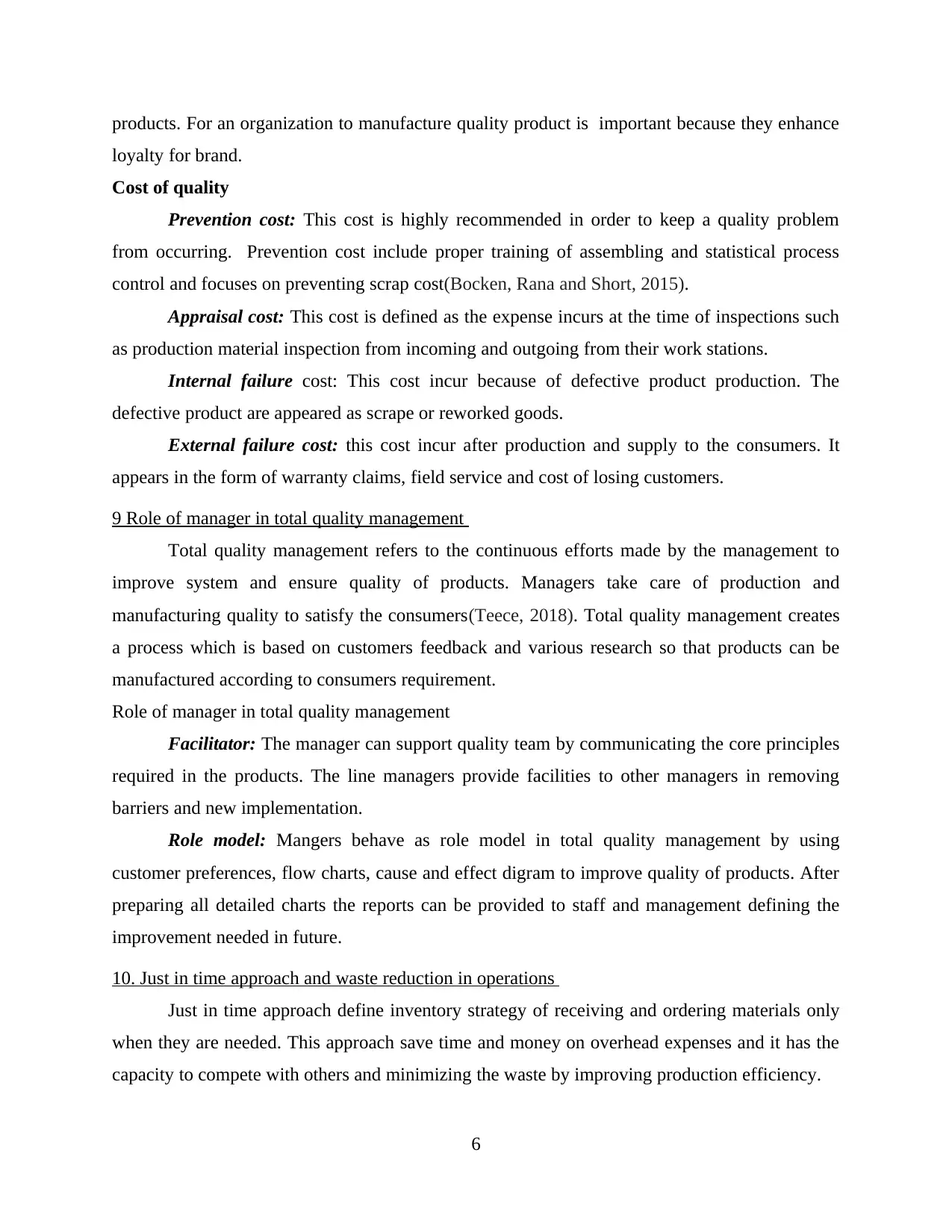
products. For an organization to manufacture quality product is important because they enhance
loyalty for brand.
Cost of quality
Prevention cost: This cost is highly recommended in order to keep a quality problem
from occurring. Prevention cost include proper training of assembling and statistical process
control and focuses on preventing scrap cost(Bocken, Rana and Short, 2015).
Appraisal cost: This cost is defined as the expense incurs at the time of inspections such
as production material inspection from incoming and outgoing from their work stations.
Internal failure cost: This cost incur because of defective product production. The
defective product are appeared as scrape or reworked goods.
External failure cost: this cost incur after production and supply to the consumers. It
appears in the form of warranty claims, field service and cost of losing customers.
9 Role of manager in total quality management
Total quality management refers to the continuous efforts made by the management to
improve system and ensure quality of products. Managers take care of production and
manufacturing quality to satisfy the consumers(Teece, 2018). Total quality management creates
a process which is based on customers feedback and various research so that products can be
manufactured according to consumers requirement.
Role of manager in total quality management
Facilitator: The manager can support quality team by communicating the core principles
required in the products. The line managers provide facilities to other managers in removing
barriers and new implementation.
Role model: Mangers behave as role model in total quality management by using
customer preferences, flow charts, cause and effect digram to improve quality of products. After
preparing all detailed charts the reports can be provided to staff and management defining the
improvement needed in future.
10. Just in time approach and waste reduction in operations
Just in time approach define inventory strategy of receiving and ordering materials only
when they are needed. This approach save time and money on overhead expenses and it has the
capacity to compete with others and minimizing the waste by improving production efficiency.
6
loyalty for brand.
Cost of quality
Prevention cost: This cost is highly recommended in order to keep a quality problem
from occurring. Prevention cost include proper training of assembling and statistical process
control and focuses on preventing scrap cost(Bocken, Rana and Short, 2015).
Appraisal cost: This cost is defined as the expense incurs at the time of inspections such
as production material inspection from incoming and outgoing from their work stations.
Internal failure cost: This cost incur because of defective product production. The
defective product are appeared as scrape or reworked goods.
External failure cost: this cost incur after production and supply to the consumers. It
appears in the form of warranty claims, field service and cost of losing customers.
9 Role of manager in total quality management
Total quality management refers to the continuous efforts made by the management to
improve system and ensure quality of products. Managers take care of production and
manufacturing quality to satisfy the consumers(Teece, 2018). Total quality management creates
a process which is based on customers feedback and various research so that products can be
manufactured according to consumers requirement.
Role of manager in total quality management
Facilitator: The manager can support quality team by communicating the core principles
required in the products. The line managers provide facilities to other managers in removing
barriers and new implementation.
Role model: Mangers behave as role model in total quality management by using
customer preferences, flow charts, cause and effect digram to improve quality of products. After
preparing all detailed charts the reports can be provided to staff and management defining the
improvement needed in future.
10. Just in time approach and waste reduction in operations
Just in time approach define inventory strategy of receiving and ordering materials only
when they are needed. This approach save time and money on overhead expenses and it has the
capacity to compete with others and minimizing the waste by improving production efficiency.
6
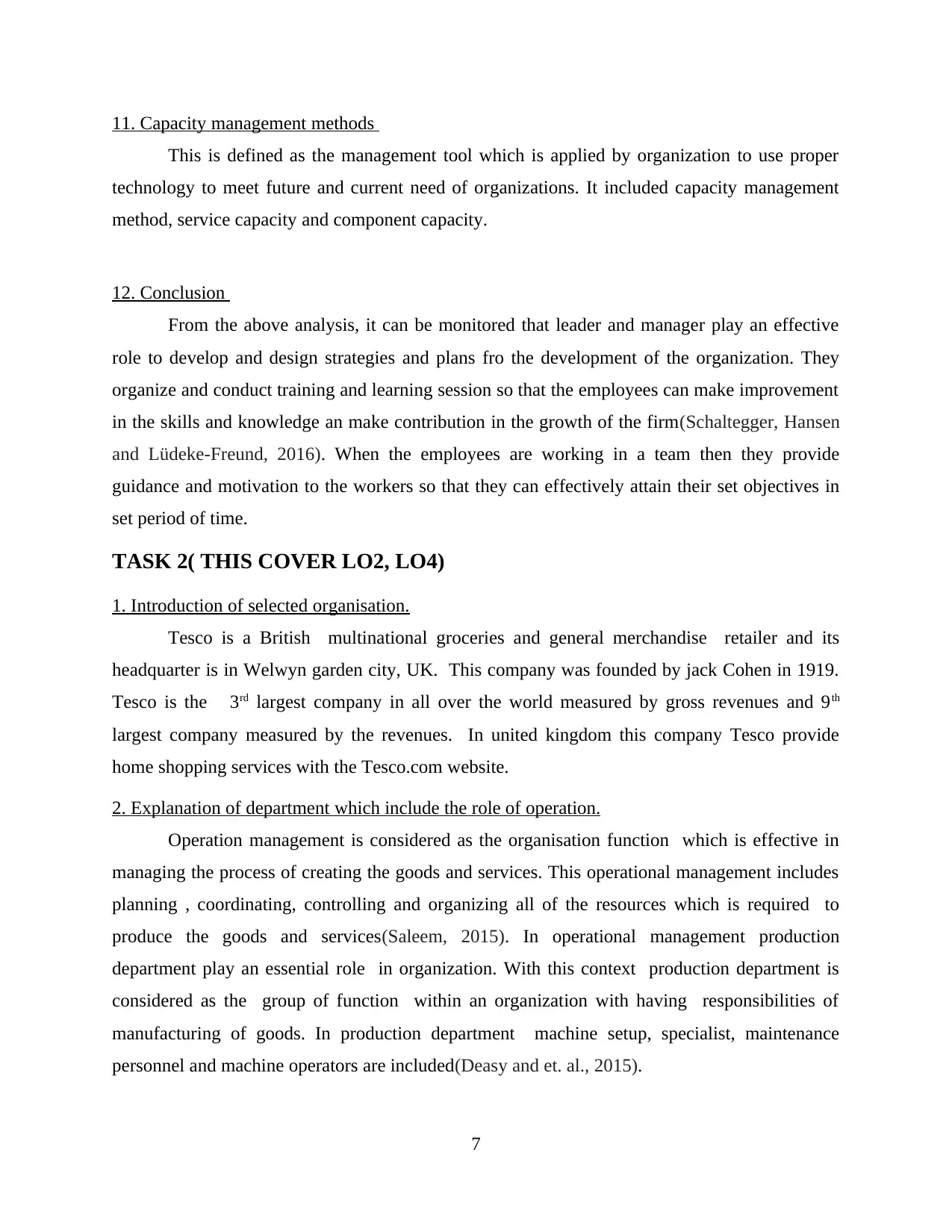
11. Capacity management methods
This is defined as the management tool which is applied by organization to use proper
technology to meet future and current need of organizations. It included capacity management
method, service capacity and component capacity.
12. Conclusion
From the above analysis, it can be monitored that leader and manager play an effective
role to develop and design strategies and plans fro the development of the organization. They
organize and conduct training and learning session so that the employees can make improvement
in the skills and knowledge an make contribution in the growth of the firm(Schaltegger, Hansen
and Lüdeke-Freund, 2016). When the employees are working in a team then they provide
guidance and motivation to the workers so that they can effectively attain their set objectives in
set period of time.
TASK 2( THIS COVER LO2, LO4)
1. Introduction of selected organisation.
Tesco is a British multinational groceries and general merchandise retailer and its
headquarter is in Welwyn garden city, UK. This company was founded by jack Cohen in 1919.
Tesco is the 3rd largest company in all over the world measured by gross revenues and 9th
largest company measured by the revenues. In united kingdom this company Tesco provide
home shopping services with the Tesco.com website.
2. Explanation of department which include the role of operation.
Operation management is considered as the organisation function which is effective in
managing the process of creating the goods and services. This operational management includes
planning , coordinating, controlling and organizing all of the resources which is required to
produce the goods and services(Saleem, 2015). In operational management production
department play an essential role in organization. With this context production department is
considered as the group of function within an organization with having responsibilities of
manufacturing of goods. In production department machine setup, specialist, maintenance
personnel and machine operators are included(Deasy and et. al., 2015).
7
This is defined as the management tool which is applied by organization to use proper
technology to meet future and current need of organizations. It included capacity management
method, service capacity and component capacity.
12. Conclusion
From the above analysis, it can be monitored that leader and manager play an effective
role to develop and design strategies and plans fro the development of the organization. They
organize and conduct training and learning session so that the employees can make improvement
in the skills and knowledge an make contribution in the growth of the firm(Schaltegger, Hansen
and Lüdeke-Freund, 2016). When the employees are working in a team then they provide
guidance and motivation to the workers so that they can effectively attain their set objectives in
set period of time.
TASK 2( THIS COVER LO2, LO4)
1. Introduction of selected organisation.
Tesco is a British multinational groceries and general merchandise retailer and its
headquarter is in Welwyn garden city, UK. This company was founded by jack Cohen in 1919.
Tesco is the 3rd largest company in all over the world measured by gross revenues and 9th
largest company measured by the revenues. In united kingdom this company Tesco provide
home shopping services with the Tesco.com website.
2. Explanation of department which include the role of operation.
Operation management is considered as the organisation function which is effective in
managing the process of creating the goods and services. This operational management includes
planning , coordinating, controlling and organizing all of the resources which is required to
produce the goods and services(Saleem, 2015). In operational management production
department play an essential role in organization. With this context production department is
considered as the group of function within an organization with having responsibilities of
manufacturing of goods. In production department machine setup, specialist, maintenance
personnel and machine operators are included(Deasy and et. al., 2015).
7
Secure Best Marks with AI Grader
Need help grading? Try our AI Grader for instant feedback on your assignments.
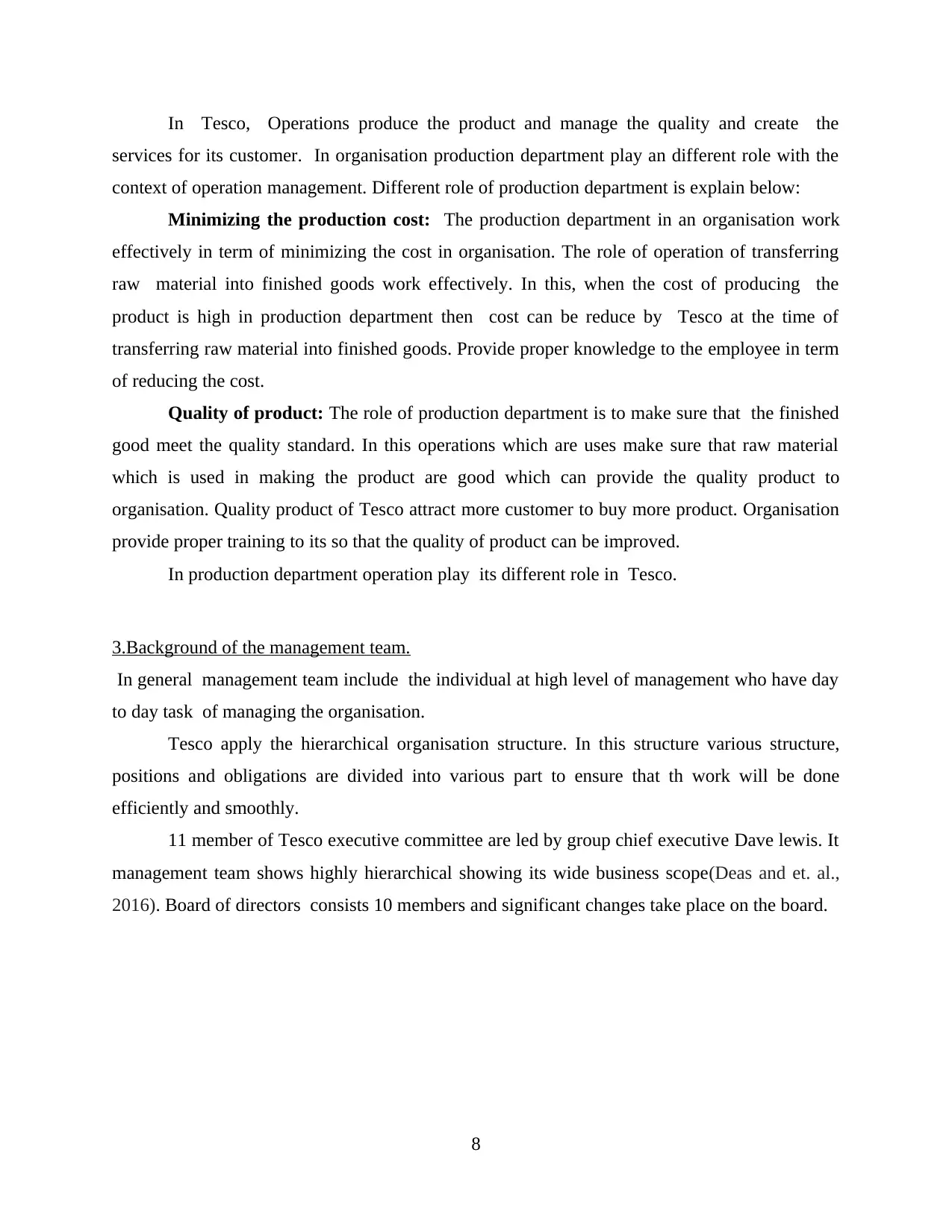
In Tesco, Operations produce the product and manage the quality and create the
services for its customer. In organisation production department play an different role with the
context of operation management. Different role of production department is explain below:
Minimizing the production cost: The production department in an organisation work
effectively in term of minimizing the cost in organisation. The role of operation of transferring
raw material into finished goods work effectively. In this, when the cost of producing the
product is high in production department then cost can be reduce by Tesco at the time of
transferring raw material into finished goods. Provide proper knowledge to the employee in term
of reducing the cost.
Quality of product: The role of production department is to make sure that the finished
good meet the quality standard. In this operations which are uses make sure that raw material
which is used in making the product are good which can provide the quality product to
organisation. Quality product of Tesco attract more customer to buy more product. Organisation
provide proper training to its so that the quality of product can be improved.
In production department operation play its different role in Tesco.
3.Background of the management team.
In general management team include the individual at high level of management who have day
to day task of managing the organisation.
Tesco apply the hierarchical organisation structure. In this structure various structure,
positions and obligations are divided into various part to ensure that th work will be done
efficiently and smoothly.
11 member of Tesco executive committee are led by group chief executive Dave lewis. It
management team shows highly hierarchical showing its wide business scope(Deas and et. al.,
2016). Board of directors consists 10 members and significant changes take place on the board.
8
services for its customer. In organisation production department play an different role with the
context of operation management. Different role of production department is explain below:
Minimizing the production cost: The production department in an organisation work
effectively in term of minimizing the cost in organisation. The role of operation of transferring
raw material into finished goods work effectively. In this, when the cost of producing the
product is high in production department then cost can be reduce by Tesco at the time of
transferring raw material into finished goods. Provide proper knowledge to the employee in term
of reducing the cost.
Quality of product: The role of production department is to make sure that the finished
good meet the quality standard. In this operations which are uses make sure that raw material
which is used in making the product are good which can provide the quality product to
organisation. Quality product of Tesco attract more customer to buy more product. Organisation
provide proper training to its so that the quality of product can be improved.
In production department operation play its different role in Tesco.
3.Background of the management team.
In general management team include the individual at high level of management who have day
to day task of managing the organisation.
Tesco apply the hierarchical organisation structure. In this structure various structure,
positions and obligations are divided into various part to ensure that th work will be done
efficiently and smoothly.
11 member of Tesco executive committee are led by group chief executive Dave lewis. It
management team shows highly hierarchical showing its wide business scope(Deas and et. al.,
2016). Board of directors consists 10 members and significant changes take place on the board.
8
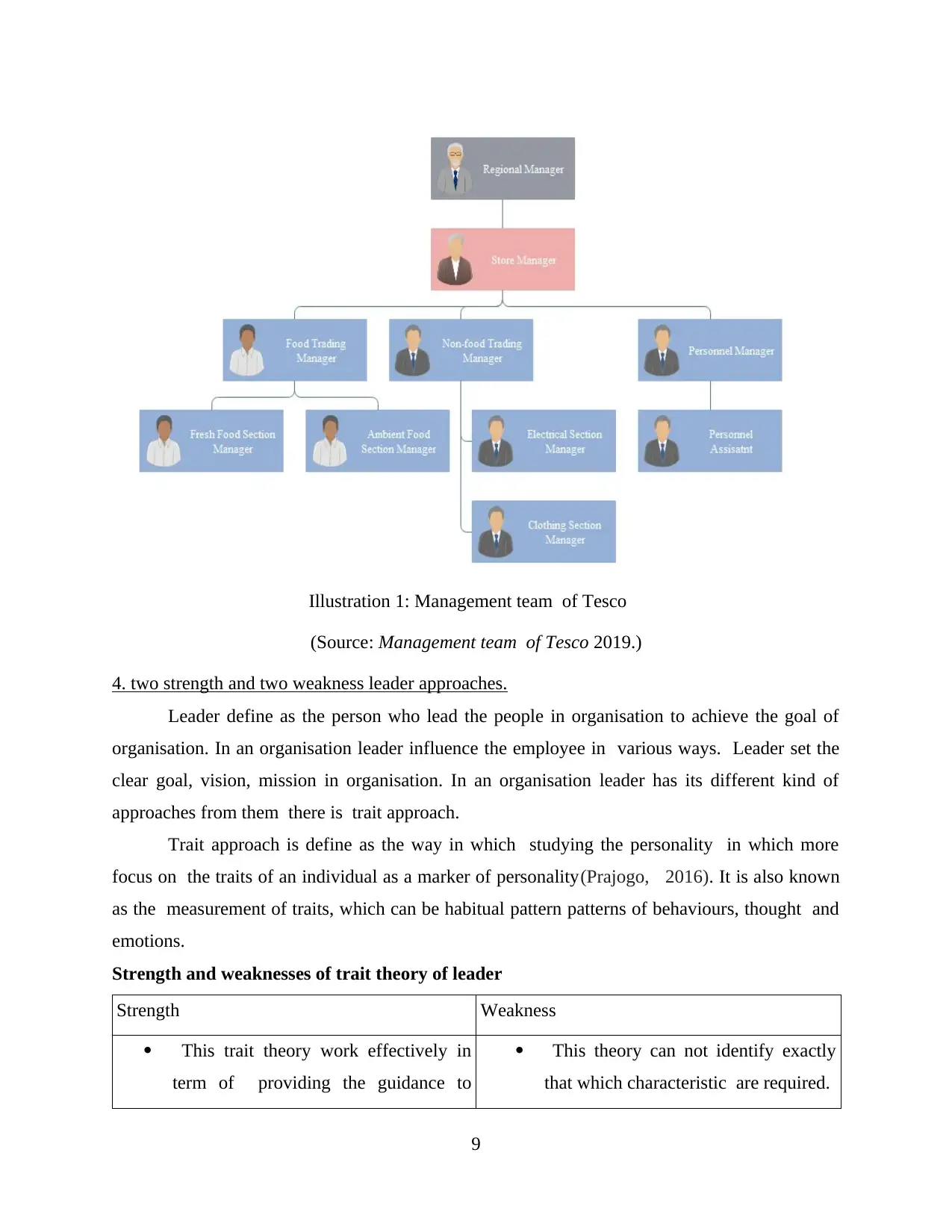
Illustration 1: Management team of Tesco
(Source: Management team of Tesco 2019.)
4. two strength and two weakness leader approaches.
Leader define as the person who lead the people in organisation to achieve the goal of
organisation. In an organisation leader influence the employee in various ways. Leader set the
clear goal, vision, mission in organisation. In an organisation leader has its different kind of
approaches from them there is trait approach.
Trait approach is define as the way in which studying the personality in which more
focus on the traits of an individual as a marker of personality(Prajogo, 2016). It is also known
as the measurement of traits, which can be habitual pattern patterns of behaviours, thought and
emotions.
Strength and weaknesses of trait theory of leader
Strength Weakness
This trait theory work effectively in
term of providing the guidance to
This theory can not identify exactly
that which characteristic are required.
9
(Source: Management team of Tesco 2019.)
4. two strength and two weakness leader approaches.
Leader define as the person who lead the people in organisation to achieve the goal of
organisation. In an organisation leader influence the employee in various ways. Leader set the
clear goal, vision, mission in organisation. In an organisation leader has its different kind of
approaches from them there is trait approach.
Trait approach is define as the way in which studying the personality in which more
focus on the traits of an individual as a marker of personality(Prajogo, 2016). It is also known
as the measurement of traits, which can be habitual pattern patterns of behaviours, thought and
emotions.
Strength and weaknesses of trait theory of leader
Strength Weakness
This trait theory work effectively in
term of providing the guidance to
This theory can not identify exactly
that which characteristic are required.
9
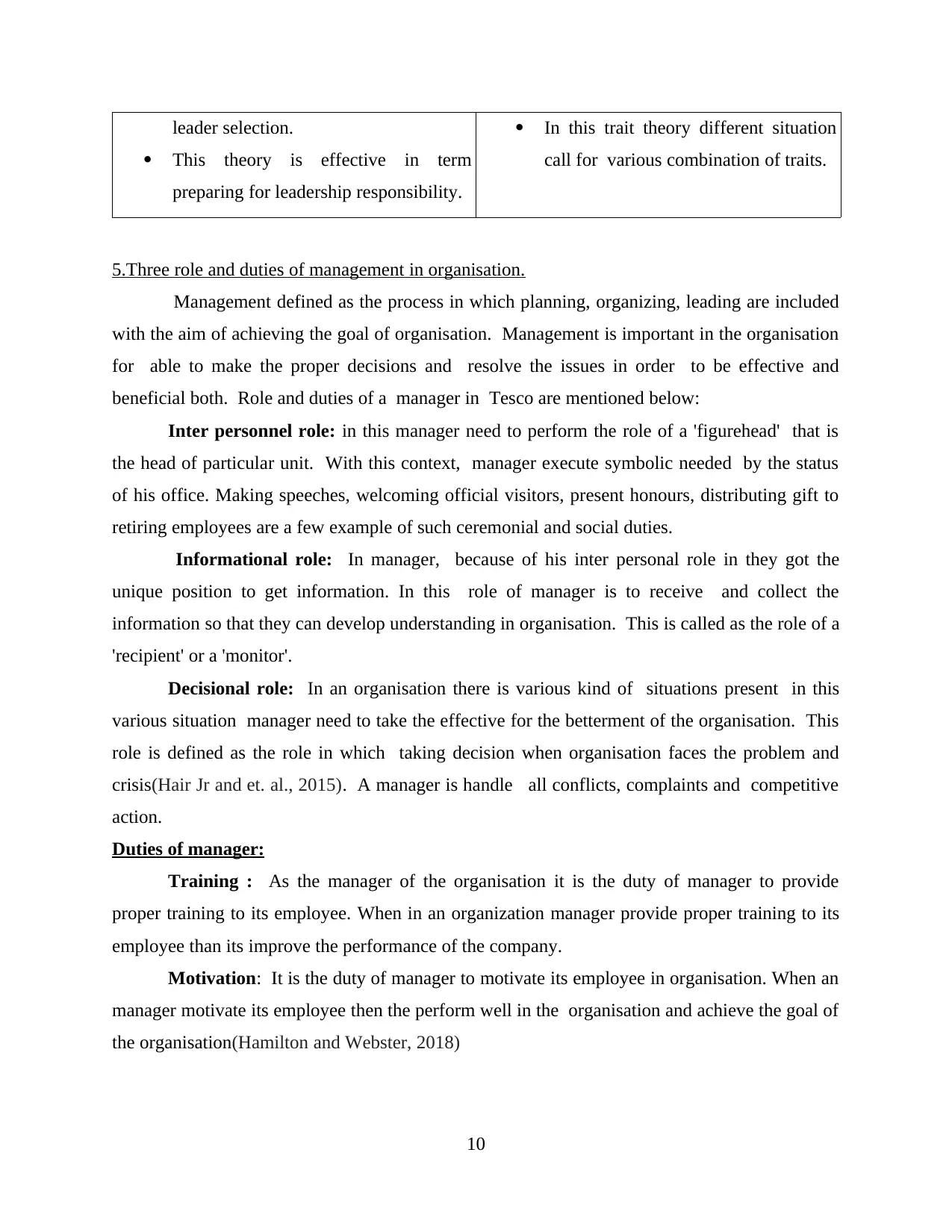
leader selection.
This theory is effective in term
preparing for leadership responsibility.
In this trait theory different situation
call for various combination of traits.
5.Three role and duties of management in organisation.
Management defined as the process in which planning, organizing, leading are included
with the aim of achieving the goal of organisation. Management is important in the organisation
for able to make the proper decisions and resolve the issues in order to be effective and
beneficial both. Role and duties of a manager in Tesco are mentioned below:
Inter personnel role: in this manager need to perform the role of a 'figurehead' that is
the head of particular unit. With this context, manager execute symbolic needed by the status
of his office. Making speeches, welcoming official visitors, present honours, distributing gift to
retiring employees are a few example of such ceremonial and social duties.
Informational role: In manager, because of his inter personal role in they got the
unique position to get information. In this role of manager is to receive and collect the
information so that they can develop understanding in organisation. This is called as the role of a
'recipient' or a 'monitor'.
Decisional role: In an organisation there is various kind of situations present in this
various situation manager need to take the effective for the betterment of the organisation. This
role is defined as the role in which taking decision when organisation faces the problem and
crisis(Hair Jr and et. al., 2015). A manager is handle all conflicts, complaints and competitive
action.
Duties of manager:
Training : As the manager of the organisation it is the duty of manager to provide
proper training to its employee. When in an organization manager provide proper training to its
employee than its improve the performance of the company.
Motivation: It is the duty of manager to motivate its employee in organisation. When an
manager motivate its employee then the perform well in the organisation and achieve the goal of
the organisation(Hamilton and Webster, 2018)
10
This theory is effective in term
preparing for leadership responsibility.
In this trait theory different situation
call for various combination of traits.
5.Three role and duties of management in organisation.
Management defined as the process in which planning, organizing, leading are included
with the aim of achieving the goal of organisation. Management is important in the organisation
for able to make the proper decisions and resolve the issues in order to be effective and
beneficial both. Role and duties of a manager in Tesco are mentioned below:
Inter personnel role: in this manager need to perform the role of a 'figurehead' that is
the head of particular unit. With this context, manager execute symbolic needed by the status
of his office. Making speeches, welcoming official visitors, present honours, distributing gift to
retiring employees are a few example of such ceremonial and social duties.
Informational role: In manager, because of his inter personal role in they got the
unique position to get information. In this role of manager is to receive and collect the
information so that they can develop understanding in organisation. This is called as the role of a
'recipient' or a 'monitor'.
Decisional role: In an organisation there is various kind of situations present in this
various situation manager need to take the effective for the betterment of the organisation. This
role is defined as the role in which taking decision when organisation faces the problem and
crisis(Hair Jr and et. al., 2015). A manager is handle all conflicts, complaints and competitive
action.
Duties of manager:
Training : As the manager of the organisation it is the duty of manager to provide
proper training to its employee. When in an organization manager provide proper training to its
employee than its improve the performance of the company.
Motivation: It is the duty of manager to motivate its employee in organisation. When an
manager motivate its employee then the perform well in the organisation and achieve the goal of
the organisation(Hamilton and Webster, 2018)
10
Paraphrase This Document
Need a fresh take? Get an instant paraphrase of this document with our AI Paraphraser
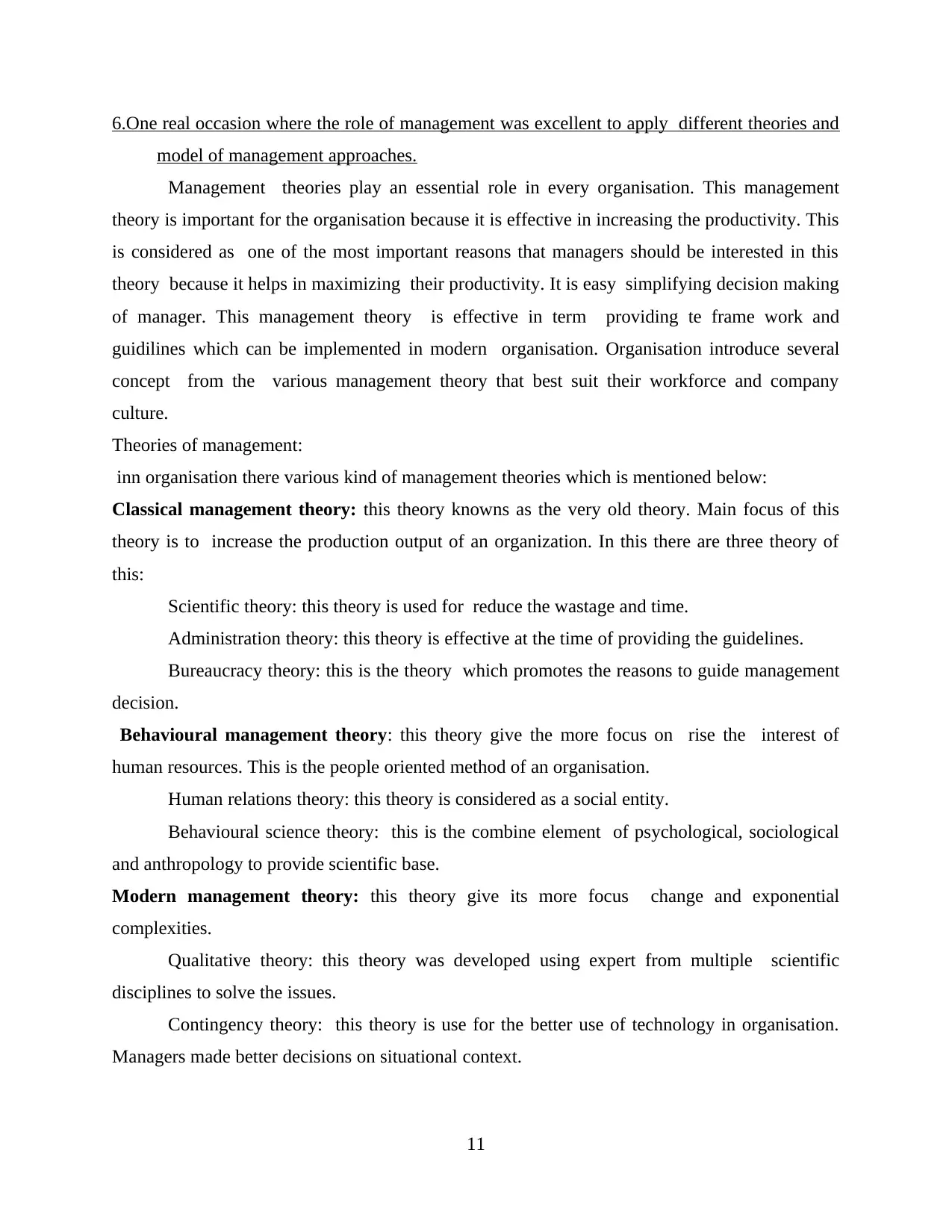
6.One real occasion where the role of management was excellent to apply different theories and
model of management approaches.
Management theories play an essential role in every organisation. This management
theory is important for the organisation because it is effective in increasing the productivity. This
is considered as one of the most important reasons that managers should be interested in this
theory because it helps in maximizing their productivity. It is easy simplifying decision making
of manager. This management theory is effective in term providing te frame work and
guidilines which can be implemented in modern organisation. Organisation introduce several
concept from the various management theory that best suit their workforce and company
culture.
Theories of management:
inn organisation there various kind of management theories which is mentioned below:
Classical management theory: this theory knowns as the very old theory. Main focus of this
theory is to increase the production output of an organization. In this there are three theory of
this:
Scientific theory: this theory is used for reduce the wastage and time.
Administration theory: this theory is effective at the time of providing the guidelines.
Bureaucracy theory: this is the theory which promotes the reasons to guide management
decision.
Behavioural management theory: this theory give the more focus on rise the interest of
human resources. This is the people oriented method of an organisation.
Human relations theory: this theory is considered as a social entity.
Behavioural science theory: this is the combine element of psychological, sociological
and anthropology to provide scientific base.
Modern management theory: this theory give its more focus change and exponential
complexities.
Qualitative theory: this theory was developed using expert from multiple scientific
disciplines to solve the issues.
Contingency theory: this theory is use for the better use of technology in organisation.
Managers made better decisions on situational context.
11
model of management approaches.
Management theories play an essential role in every organisation. This management
theory is important for the organisation because it is effective in increasing the productivity. This
is considered as one of the most important reasons that managers should be interested in this
theory because it helps in maximizing their productivity. It is easy simplifying decision making
of manager. This management theory is effective in term providing te frame work and
guidilines which can be implemented in modern organisation. Organisation introduce several
concept from the various management theory that best suit their workforce and company
culture.
Theories of management:
inn organisation there various kind of management theories which is mentioned below:
Classical management theory: this theory knowns as the very old theory. Main focus of this
theory is to increase the production output of an organization. In this there are three theory of
this:
Scientific theory: this theory is used for reduce the wastage and time.
Administration theory: this theory is effective at the time of providing the guidelines.
Bureaucracy theory: this is the theory which promotes the reasons to guide management
decision.
Behavioural management theory: this theory give the more focus on rise the interest of
human resources. This is the people oriented method of an organisation.
Human relations theory: this theory is considered as a social entity.
Behavioural science theory: this is the combine element of psychological, sociological
and anthropology to provide scientific base.
Modern management theory: this theory give its more focus change and exponential
complexities.
Qualitative theory: this theory was developed using expert from multiple scientific
disciplines to solve the issues.
Contingency theory: this theory is use for the better use of technology in organisation.
Managers made better decisions on situational context.
11
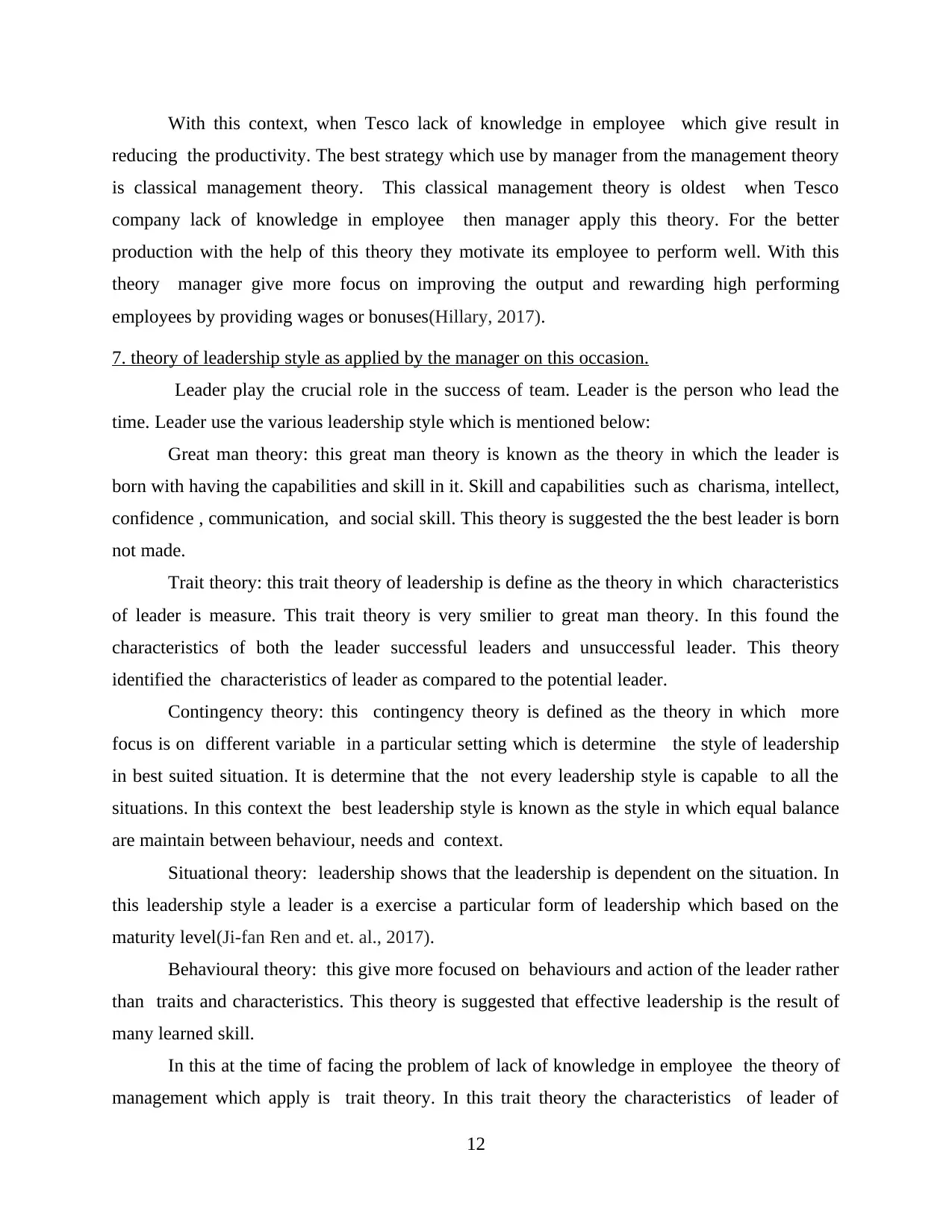
With this context, when Tesco lack of knowledge in employee which give result in
reducing the productivity. The best strategy which use by manager from the management theory
is classical management theory. This classical management theory is oldest when Tesco
company lack of knowledge in employee then manager apply this theory. For the better
production with the help of this theory they motivate its employee to perform well. With this
theory manager give more focus on improving the output and rewarding high performing
employees by providing wages or bonuses(Hillary, 2017).
7. theory of leadership style as applied by the manager on this occasion.
Leader play the crucial role in the success of team. Leader is the person who lead the
time. Leader use the various leadership style which is mentioned below:
Great man theory: this great man theory is known as the theory in which the leader is
born with having the capabilities and skill in it. Skill and capabilities such as charisma, intellect,
confidence , communication, and social skill. This theory is suggested the the best leader is born
not made.
Trait theory: this trait theory of leadership is define as the theory in which characteristics
of leader is measure. This trait theory is very smilier to great man theory. In this found the
characteristics of both the leader successful leaders and unsuccessful leader. This theory
identified the characteristics of leader as compared to the potential leader.
Contingency theory: this contingency theory is defined as the theory in which more
focus is on different variable in a particular setting which is determine the style of leadership
in best suited situation. It is determine that the not every leadership style is capable to all the
situations. In this context the best leadership style is known as the style in which equal balance
are maintain between behaviour, needs and context.
Situational theory: leadership shows that the leadership is dependent on the situation. In
this leadership style a leader is a exercise a particular form of leadership which based on the
maturity level(Ji-fan Ren and et. al., 2017).
Behavioural theory: this give more focused on behaviours and action of the leader rather
than traits and characteristics. This theory is suggested that effective leadership is the result of
many learned skill.
In this at the time of facing the problem of lack of knowledge in employee the theory of
management which apply is trait theory. In this trait theory the characteristics of leader of
12
reducing the productivity. The best strategy which use by manager from the management theory
is classical management theory. This classical management theory is oldest when Tesco
company lack of knowledge in employee then manager apply this theory. For the better
production with the help of this theory they motivate its employee to perform well. With this
theory manager give more focus on improving the output and rewarding high performing
employees by providing wages or bonuses(Hillary, 2017).
7. theory of leadership style as applied by the manager on this occasion.
Leader play the crucial role in the success of team. Leader is the person who lead the
time. Leader use the various leadership style which is mentioned below:
Great man theory: this great man theory is known as the theory in which the leader is
born with having the capabilities and skill in it. Skill and capabilities such as charisma, intellect,
confidence , communication, and social skill. This theory is suggested the the best leader is born
not made.
Trait theory: this trait theory of leadership is define as the theory in which characteristics
of leader is measure. This trait theory is very smilier to great man theory. In this found the
characteristics of both the leader successful leaders and unsuccessful leader. This theory
identified the characteristics of leader as compared to the potential leader.
Contingency theory: this contingency theory is defined as the theory in which more
focus is on different variable in a particular setting which is determine the style of leadership
in best suited situation. It is determine that the not every leadership style is capable to all the
situations. In this context the best leadership style is known as the style in which equal balance
are maintain between behaviour, needs and context.
Situational theory: leadership shows that the leadership is dependent on the situation. In
this leadership style a leader is a exercise a particular form of leadership which based on the
maturity level(Ji-fan Ren and et. al., 2017).
Behavioural theory: this give more focused on behaviours and action of the leader rather
than traits and characteristics. This theory is suggested that effective leadership is the result of
many learned skill.
In this at the time of facing the problem of lack of knowledge in employee the theory of
management which apply is trait theory. In this trait theory the characteristics of leader of
12
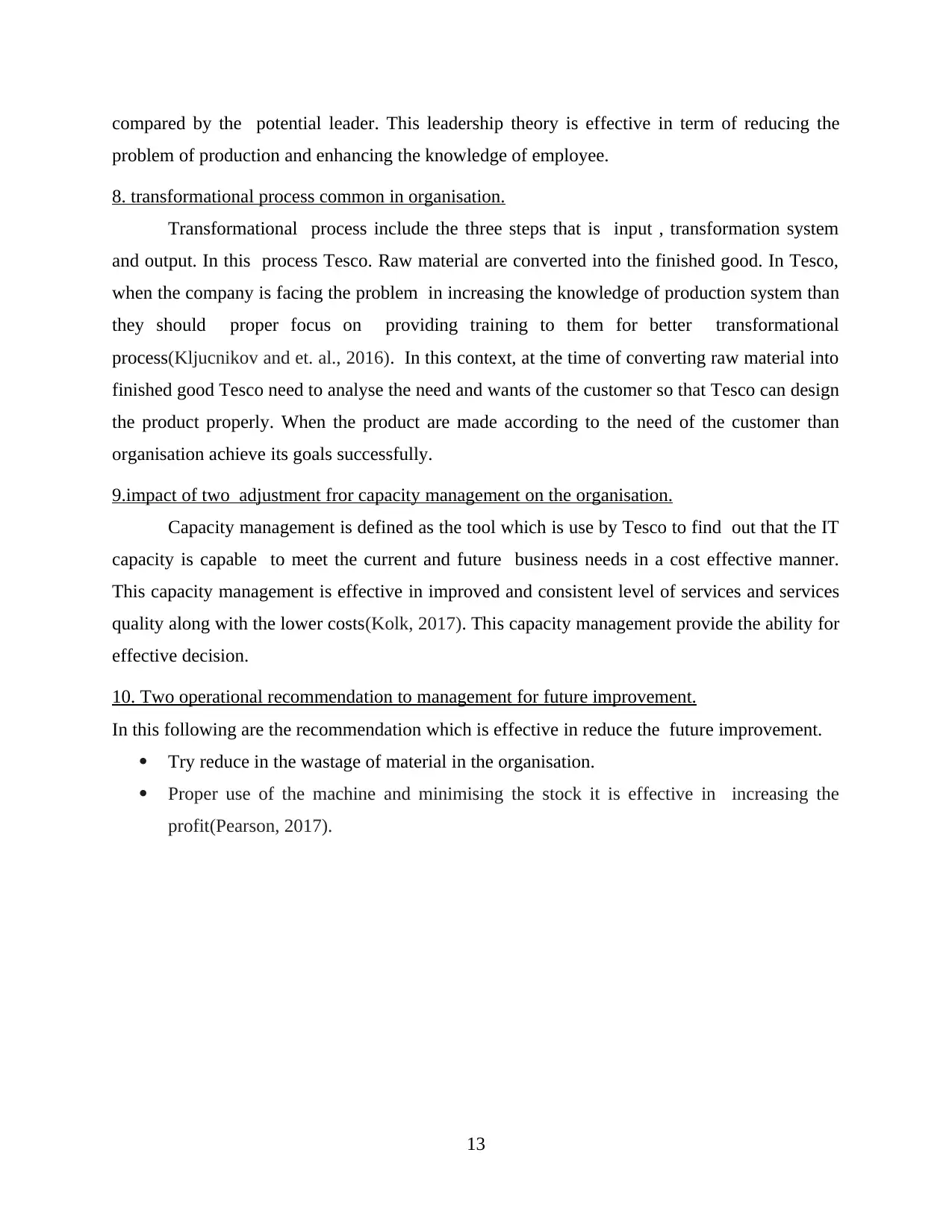
compared by the potential leader. This leadership theory is effective in term of reducing the
problem of production and enhancing the knowledge of employee.
8. transformational process common in organisation.
Transformational process include the three steps that is input , transformation system
and output. In this process Tesco. Raw material are converted into the finished good. In Tesco,
when the company is facing the problem in increasing the knowledge of production system than
they should proper focus on providing training to them for better transformational
process(Kljucnikov and et. al., 2016). In this context, at the time of converting raw material into
finished good Tesco need to analyse the need and wants of the customer so that Tesco can design
the product properly. When the product are made according to the need of the customer than
organisation achieve its goals successfully.
9.impact of two adjustment fror capacity management on the organisation.
Capacity management is defined as the tool which is use by Tesco to find out that the IT
capacity is capable to meet the current and future business needs in a cost effective manner.
This capacity management is effective in improved and consistent level of services and services
quality along with the lower costs(Kolk, 2017). This capacity management provide the ability for
effective decision.
10. Two operational recommendation to management for future improvement.
In this following are the recommendation which is effective in reduce the future improvement.
Try reduce in the wastage of material in the organisation.
Proper use of the machine and minimising the stock it is effective in increasing the
profit(Pearson, 2017).
13
problem of production and enhancing the knowledge of employee.
8. transformational process common in organisation.
Transformational process include the three steps that is input , transformation system
and output. In this process Tesco. Raw material are converted into the finished good. In Tesco,
when the company is facing the problem in increasing the knowledge of production system than
they should proper focus on providing training to them for better transformational
process(Kljucnikov and et. al., 2016). In this context, at the time of converting raw material into
finished good Tesco need to analyse the need and wants of the customer so that Tesco can design
the product properly. When the product are made according to the need of the customer than
organisation achieve its goals successfully.
9.impact of two adjustment fror capacity management on the organisation.
Capacity management is defined as the tool which is use by Tesco to find out that the IT
capacity is capable to meet the current and future business needs in a cost effective manner.
This capacity management is effective in improved and consistent level of services and services
quality along with the lower costs(Kolk, 2017). This capacity management provide the ability for
effective decision.
10. Two operational recommendation to management for future improvement.
In this following are the recommendation which is effective in reduce the future improvement.
Try reduce in the wastage of material in the organisation.
Proper use of the machine and minimising the stock it is effective in increasing the
profit(Pearson, 2017).
13
Secure Best Marks with AI Grader
Need help grading? Try our AI Grader for instant feedback on your assignments.
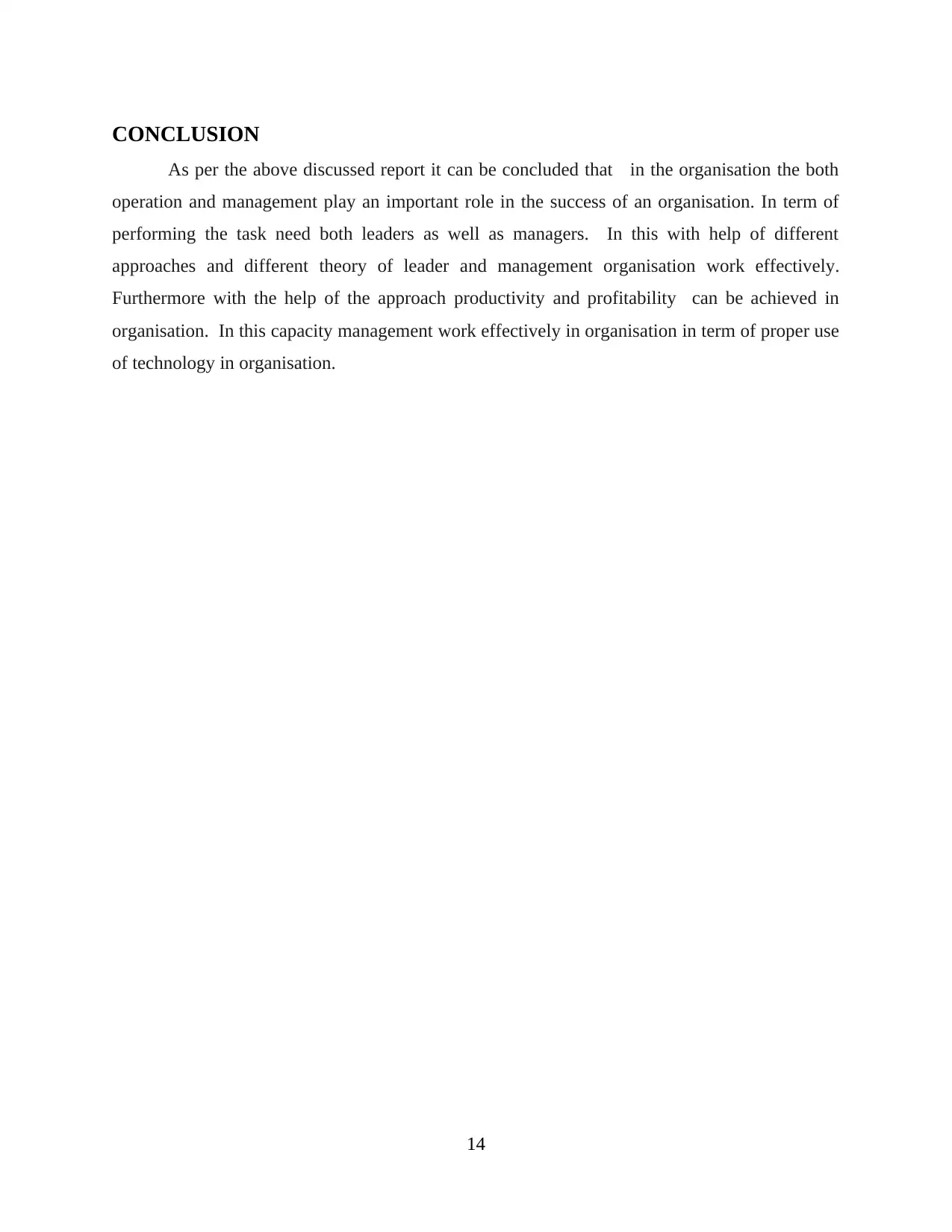
CONCLUSION
As per the above discussed report it can be concluded that in the organisation the both
operation and management play an important role in the success of an organisation. In term of
performing the task need both leaders as well as managers. In this with help of different
approaches and different theory of leader and management organisation work effectively.
Furthermore with the help of the approach productivity and profitability can be achieved in
organisation. In this capacity management work effectively in organisation in term of proper use
of technology in organisation.
14
As per the above discussed report it can be concluded that in the organisation the both
operation and management play an important role in the success of an organisation. In term of
performing the task need both leaders as well as managers. In this with help of different
approaches and different theory of leader and management organisation work effectively.
Furthermore with the help of the approach productivity and profitability can be achieved in
organisation. In this capacity management work effectively in organisation in term of proper use
of technology in organisation.
14
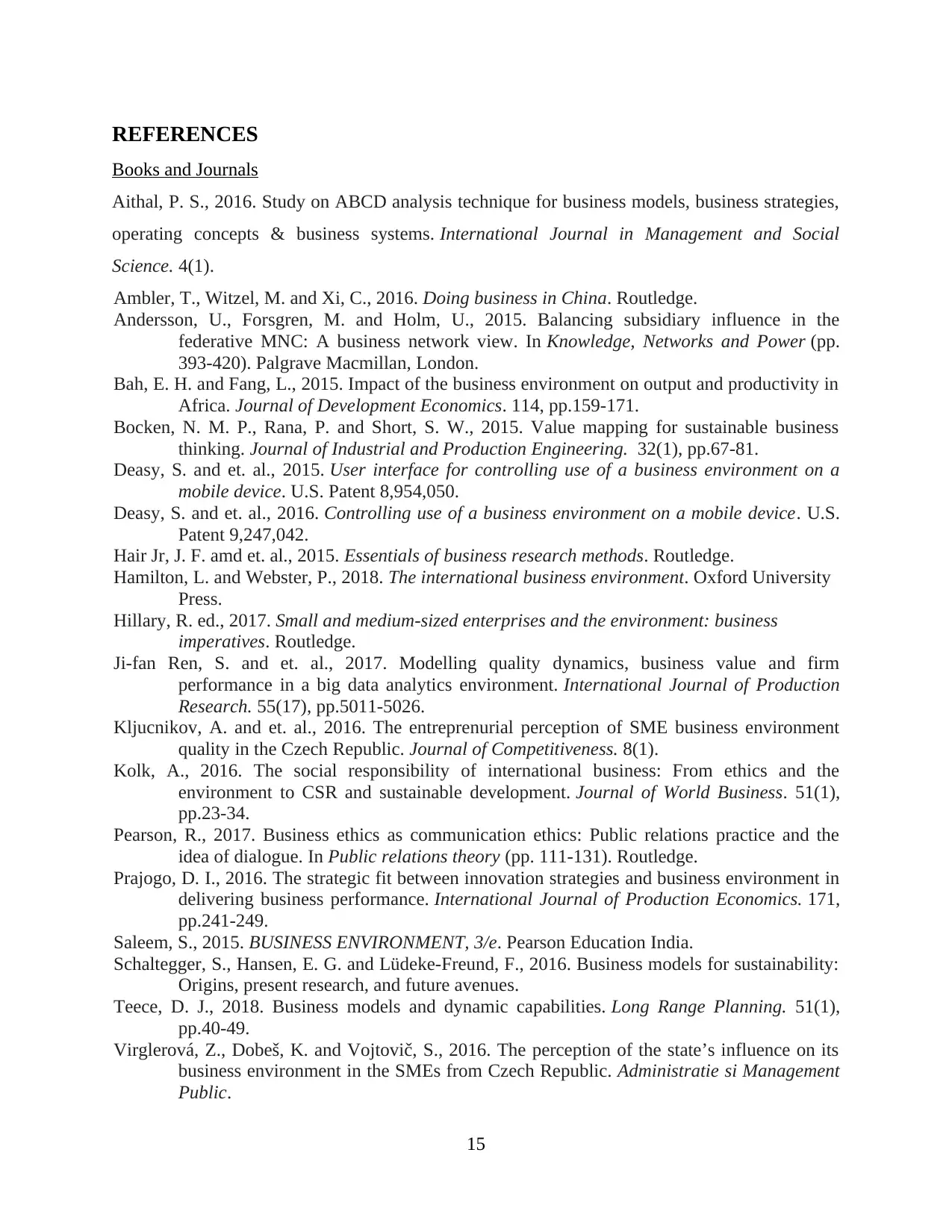
REFERENCES
Books and Journals
Aithal, P. S., 2016. Study on ABCD analysis technique for business models, business strategies,
operating concepts & business systems. International Journal in Management and Social
Science. 4(1).
Ambler, T., Witzel, M. and Xi, C., 2016. Doing business in China. Routledge.
Andersson, U., Forsgren, M. and Holm, U., 2015. Balancing subsidiary influence in the
federative MNC: A business network view. In Knowledge, Networks and Power (pp.
393-420). Palgrave Macmillan, London.
Bah, E. H. and Fang, L., 2015. Impact of the business environment on output and productivity in
Africa. Journal of Development Economics. 114, pp.159-171.
Bocken, N. M. P., Rana, P. and Short, S. W., 2015. Value mapping for sustainable business
thinking. Journal of Industrial and Production Engineering. 32(1), pp.67-81.
Deasy, S. and et. al., 2015. User interface for controlling use of a business environment on a
mobile device. U.S. Patent 8,954,050.
Deasy, S. and et. al., 2016. Controlling use of a business environment on a mobile device. U.S.
Patent 9,247,042.
Hair Jr, J. F. amd et. al., 2015. Essentials of business research methods. Routledge.
Hamilton, L. and Webster, P., 2018. The international business environment. Oxford University
Press.
Hillary, R. ed., 2017. Small and medium-sized enterprises and the environment: business
imperatives. Routledge.
Ji-fan Ren, S. and et. al., 2017. Modelling quality dynamics, business value and firm
performance in a big data analytics environment. International Journal of Production
Research. 55(17), pp.5011-5026.
Kljucnikov, A. and et. al., 2016. The entreprenurial perception of SME business environment
quality in the Czech Republic. Journal of Competitiveness. 8(1).
Kolk, A., 2016. The social responsibility of international business: From ethics and the
environment to CSR and sustainable development. Journal of World Business. 51(1),
pp.23-34.
Pearson, R., 2017. Business ethics as communication ethics: Public relations practice and the
idea of dialogue. In Public relations theory (pp. 111-131). Routledge.
Prajogo, D. I., 2016. The strategic fit between innovation strategies and business environment in
delivering business performance. International Journal of Production Economics. 171,
pp.241-249.
Saleem, S., 2015. BUSINESS ENVIRONMENT, 3/e. Pearson Education India.
Schaltegger, S., Hansen, E. G. and Lüdeke-Freund, F., 2016. Business models for sustainability:
Origins, present research, and future avenues.
Teece, D. J., 2018. Business models and dynamic capabilities. Long Range Planning. 51(1),
pp.40-49.
Virglerová, Z., Dobeš, K. and Vojtovič, S., 2016. The perception of the state’s influence on its
business environment in the SMEs from Czech Republic. Administratie si Management
Public.
15
Books and Journals
Aithal, P. S., 2016. Study on ABCD analysis technique for business models, business strategies,
operating concepts & business systems. International Journal in Management and Social
Science. 4(1).
Ambler, T., Witzel, M. and Xi, C., 2016. Doing business in China. Routledge.
Andersson, U., Forsgren, M. and Holm, U., 2015. Balancing subsidiary influence in the
federative MNC: A business network view. In Knowledge, Networks and Power (pp.
393-420). Palgrave Macmillan, London.
Bah, E. H. and Fang, L., 2015. Impact of the business environment on output and productivity in
Africa. Journal of Development Economics. 114, pp.159-171.
Bocken, N. M. P., Rana, P. and Short, S. W., 2015. Value mapping for sustainable business
thinking. Journal of Industrial and Production Engineering. 32(1), pp.67-81.
Deasy, S. and et. al., 2015. User interface for controlling use of a business environment on a
mobile device. U.S. Patent 8,954,050.
Deasy, S. and et. al., 2016. Controlling use of a business environment on a mobile device. U.S.
Patent 9,247,042.
Hair Jr, J. F. amd et. al., 2015. Essentials of business research methods. Routledge.
Hamilton, L. and Webster, P., 2018. The international business environment. Oxford University
Press.
Hillary, R. ed., 2017. Small and medium-sized enterprises and the environment: business
imperatives. Routledge.
Ji-fan Ren, S. and et. al., 2017. Modelling quality dynamics, business value and firm
performance in a big data analytics environment. International Journal of Production
Research. 55(17), pp.5011-5026.
Kljucnikov, A. and et. al., 2016. The entreprenurial perception of SME business environment
quality in the Czech Republic. Journal of Competitiveness. 8(1).
Kolk, A., 2016. The social responsibility of international business: From ethics and the
environment to CSR and sustainable development. Journal of World Business. 51(1),
pp.23-34.
Pearson, R., 2017. Business ethics as communication ethics: Public relations practice and the
idea of dialogue. In Public relations theory (pp. 111-131). Routledge.
Prajogo, D. I., 2016. The strategic fit between innovation strategies and business environment in
delivering business performance. International Journal of Production Economics. 171,
pp.241-249.
Saleem, S., 2015. BUSINESS ENVIRONMENT, 3/e. Pearson Education India.
Schaltegger, S., Hansen, E. G. and Lüdeke-Freund, F., 2016. Business models for sustainability:
Origins, present research, and future avenues.
Teece, D. J., 2018. Business models and dynamic capabilities. Long Range Planning. 51(1),
pp.40-49.
Virglerová, Z., Dobeš, K. and Vojtovič, S., 2016. The perception of the state’s influence on its
business environment in the SMEs from Czech Republic. Administratie si Management
Public.
15

16
1 out of 19
Related Documents
Your All-in-One AI-Powered Toolkit for Academic Success.
+13062052269
info@desklib.com
Available 24*7 on WhatsApp / Email
![[object Object]](/_next/static/media/star-bottom.7253800d.svg)
Unlock your academic potential
© 2024 | Zucol Services PVT LTD | All rights reserved.





